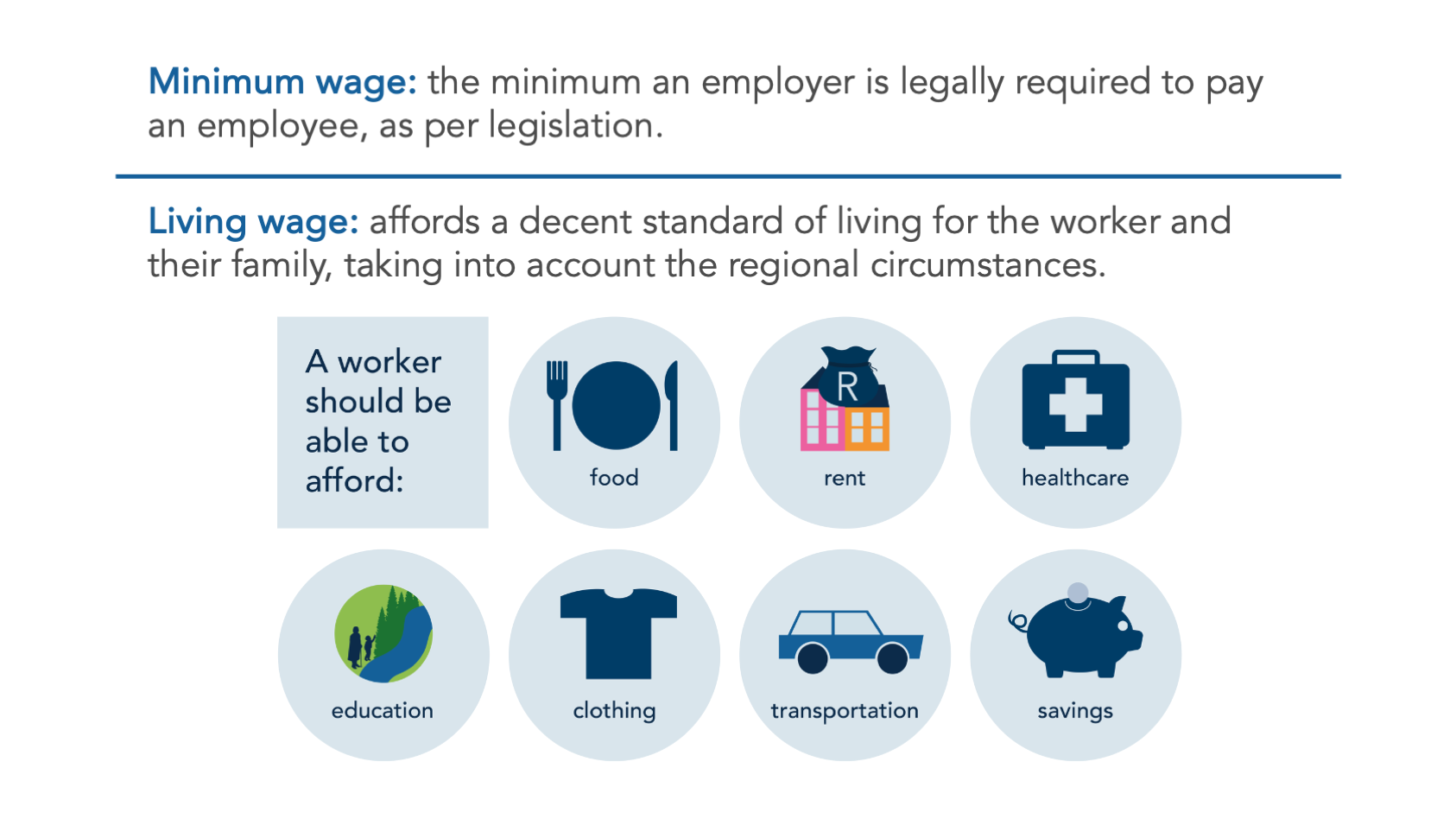Upholding the Human Right to a Living Wage Is Essential for Business
Share this post on:LinkedIn

Image by SolaGratia on Pixabay
This blog was originally published in 2021, and was updated in May 2024 for accuracy and relevance.
Many companies are struggling in the face of a global labour shortage, a trend only accelerated in recent years by the COVID-19 pandemic.
The reality, however, is that we are facing a WAGE shortage.
In the face of persistent economic and social challenges, workers are showing less and less tolerance for low-paying and strenuous working conditions that don’t allow them or their families to thrive.
Fortunately, leading companies have found a sensible solution: pay people a wage that they and their family can reliably live on.
In this blog post, we explore the right to a living wage to help you to understand why fair compensation is relevant for companies and how you can get started on your journey.
What Is a Living Wage?
The topic of a living wage has long been confused with that of a minimum wage. A minimum wage is precisely that: the minimum that an employer is legally required to pay an employee, as per legislation. It does not account for cost of living or inflation, and is intended only to curb the extent to which employees are exploited.

Minimum wage vs living wage. Embedding Project.
By contrast, a living wage is one that affords a decent standard of living for the worker and their family in the regions where they work. This includes food, water, housing, education, health care, transportation, clothing, and other essential needs, including provisions for unexpected events. It is a wage that helps families to achieve independence and an existence worthy of human dignity.
Paying a living wage is not an act of benevolence.
The right to “just and favourable remuneration ensuring for [themselves] and for [their] family an existence worthy of human dignity“ was declared in 1948 in the UN Universal Declaration of Human Rights. This right was ratified by the UN General Assembly in 1966 and enshrined into international law in 1976.
If your company commits to respecting human rights, ensuring fair compensation in your organisation and value chain needs to be part of that agenda.
The Growing Wage Gap
In a healthy economy, we would expect to see rising wages and stronger workers’ bargaining power. Instead, we’ve seen exacerbating economic inequalities across the world and the burgeoning wealth gap has become common knowledge. Since 2020, almost five billion people globally have become poorer. As Oxfam International aptly puts it, “at current rates, it will take 230 years to end poverty, but we could have our first trillionaire in a decade.”
Employers are failing to treat employees like the assets they are – and for many industries, the implications are costly, and threaten to be long-term.
Why Fair Compensation Matters to Your Company
The answer to finding and securing a reliable workforce is simple and straightforward: companies need to provide their workers with fair compensation. This is not only a matter of respecting human dignity and human rights; it’s a strategic imperative for business continuity and for a healthy and equitable economy.
Ensuring that you pay employees at least a living wage can help to improve your company’s reputation and attract quality candidates; reduce employee turnover, absenteeism, and retraining costs; improve performance and productivity; and ensure that your company’s investments in capacity-building are retained within the organisation.
Effective implementation of a living wage program in your company requires executive support, engagement with your workers, and collaboration with internal working group(s) of affected departments, such as HR, marketing, and operations.
Getting Started on Your Fair Compensation Journey
If your company is ready to consider fair compensation and understand its role in addressing income inequity, here is where you can start:
1) Understand and calculate a living wage in the regions where you operate.
Start by understanding and calculating an appropriate living wage for the region (or regions) where you operate. The Global Living Wage Coalition offers an estimation of living wages in over 50 countries around the world, and the IDH Roadmap on Living Wages can provide guidance on finding credible living wage benchmarks.
2) Undertake a wage gap assessment.
Use this information to undertake a wage gap analysis to identify gaps between what workers are paid and the relevant benchmarks in your region. The Living Wage Analysis Tool by United Nations Global Compact can help you assess current policies and highlight areas for improvement. You should also look at historical trends that perpetuate and exacerbate wage inequality – divide your remuneration into meaningful brackets (this could be quartiles or deciles) and look to see which groups have been experiencing the highest and lowest gains as a percentage of income over time.
3) Develop a fair compensation plan.
Develop a plan to ensure all workers will be paid a living wage – and more broadly, consider targeting structural wage inequalities by working to ensure that wages in the lower income brackets in your organisation rise faster than those in the higher income brackets.
Action required to close the wage gap will differ greatly between organisations and supply chains. This interactive IDH Living Wage Action Guide offers interventions and practical tips, divided into sections that address various common challenges that your organisation may face during this journey. This Living Income Toolkit by the Living Income Community of Practice can also provide guidance on how to mainstream living incomes in your company’s activities to address poverty within supply chains.
4) Support fair compensation in your value chain.
For many companies, the need for a living wage is particularly acute in their value chain. By starting within your own organisation, you can use that momentum and those learnings to engage your suppliers on the need for fair compensation.It begins with undertaking research to better understand your value chain and the relevant regional contexts. Next, you will need to engage in conversations with suppliers and work together to explore the strategic implications of pursuing fair compensation.
Even large companies can struggle to leverage their influence within their value chain to ensure that workers are receiving fair remuneration. But more companies are doing so. For example, Vancity discovered that its living wage mandate strengthened its partnerships with suppliers, and supplier advocacy of a living wage cascaded into broader industry associations.
Recognise That a Living wage Is Really Just the Beginning
A living wage or living income (for those who are salaried) is a foundation, not the final destination. It is what is required just to reasonably get by and should be understood as the true minimum that a worker can be paid to afford a decent standard of living.
A living wage is often defined as the pay necessary to maintain a decent standard of living, but what is decent? While covering essential expenses, even a living wage often fails to account for savings, retirement, or allocations for children’s care and educational needs.
The consideration of a living wage is also often based on a nuclear family constellation of two working parents with two children. However, actual income earners may have single income or single parent households, or more children, or they may be providing for sick parents, or supporting a broader family. They themselves may also have unique and pressing needs that are not adequately accounted for in standard calculations.
As you contemplate what fair compensation would look like in your organisation, consider what a thriving wage would look like and mean for your employees, such as enabling them to pursue their hobbies, invest in personal development, and to help their families do the same.
Living wages are also only part of the solution to enabling decent and dignified lives. Respect, transparency, working conditions, and benefits must also be part of a wholistic conversation about acceptable remuneration, as should flexible schedules and locations (when possible) and sick leave that protects workers.
Be a Part of the Change
All of us need a living wage and no job should be without dignity. Paying less than a living wage is exploitative, keeps people in poverty, and strains local social systems. Employees earning less than a living wage end up making hard choices between meeting essential needs – and this mismatch between wages and needs is resulting in mounting uncertainty and continuity risks for business.
Well paid workers are happier, loyal, reliable workers. If your organisation has a vacancy and needs a person to fill it, ensure that role offers a living wage. Turns out, it pays off.
If you’re ready to start your journey towards a living wage, explore our Fair Compensation: A Getting Started Guide, or our issue snapshot on fair compensation, for further resources and guidance.
Footnotes
Image by SolaGratia on Pixabay.